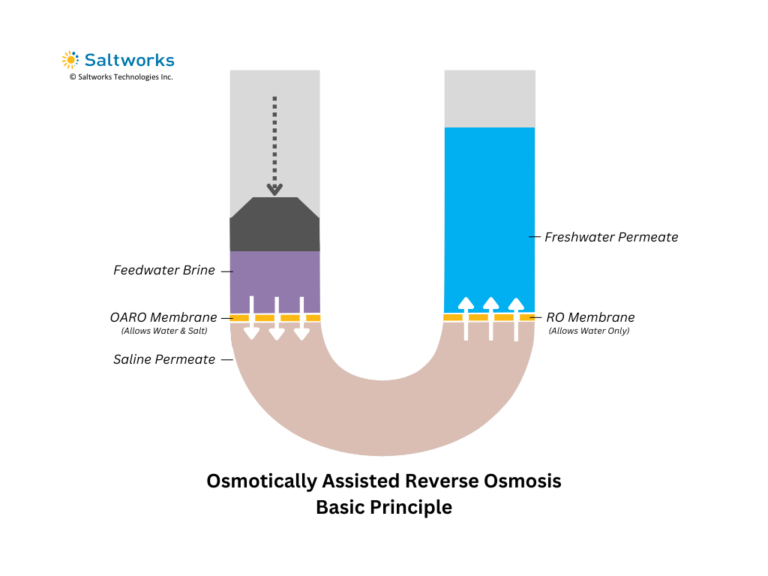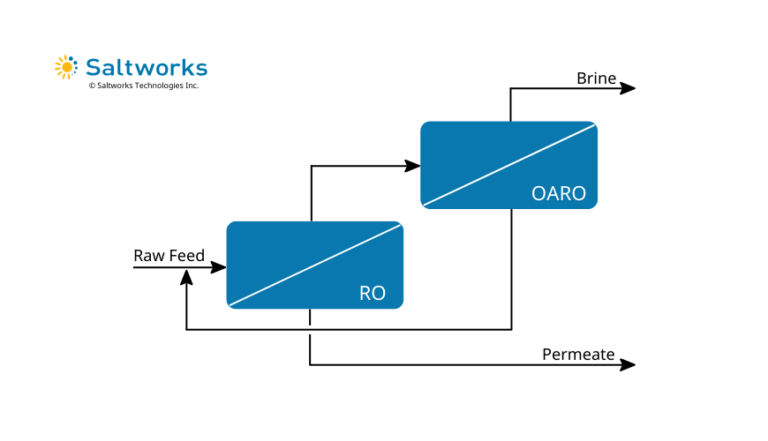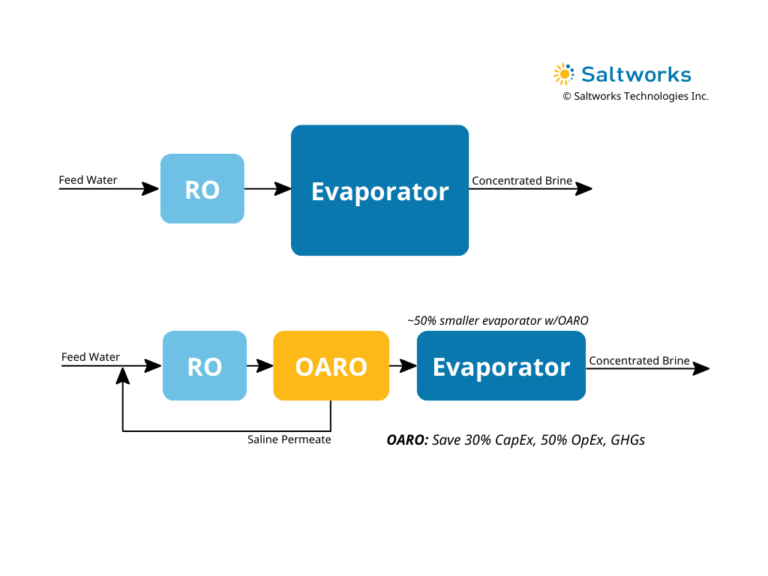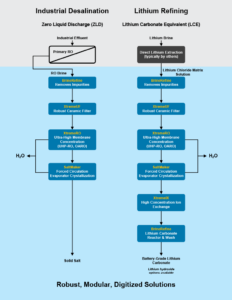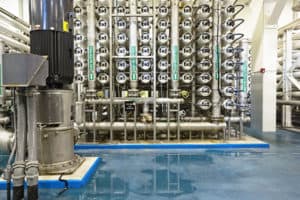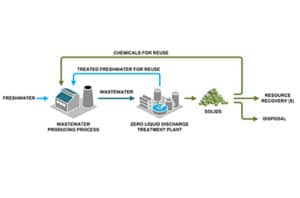Osmotically Assisted Reverse Osmosis: An Inflection Point in Membrane-Brine Concentration Technology
Background and implementation of osmotically assisted reverse osmosis (OARO)
Nov 10th 2023
Article Highlights
- OARO can achieve brine concentrations of >200,000 mg/L given the right conditions, enabling 50-80% higher brine concentration than ultra-high pressure reverse osmosis (UHP RO).
- OARO, consisting of a series of cascading loops, has been widely published, discussed, and tested. OARO is ‘open technology’ and should not be confused with forward osmosis.
- As of 2023, OARO has not yet reached commercialization owing in part to a lack of standardized mass-produced membranes coupled with process complexity.
- The technology is at a turning point as global membrane manufacturers are now mass-producing quality-assured spiral wound thin film composite OARO membranes and incremental innovations have solved the process complexity challenge.
- Expert support is required to ensure OARO can seamlessly integrate with existing processing technology while membrane health is protected.
OARO Overview
While osmotically assisted reverse osmosis (OARO) is not widely used across the water treatment sector, it has long had the potential to drastically improve the economics of membrane-brine concentration systems.
OARO can achieve sodium chloride brine concentrations >200,000 mg/L vs. 120 bar ultra-high-pressure RO’s (UHP RO) 130,000 mg/L. This increase in brine concentration capability comes at the expense of added process complexity and energy requirements versus traditional reverse osmosis processes. For the purposes of this article, OARO and low salt rejection RO (LSSRO) share the same process definition.
Despite its potential, OARO technology is not a new revolution. It is lesser known compared to traditional reverse osmosis (RO) and evaporator combinations—largely due to gaps in membrane supply and a lack of legitimate full-scale installations, proving that more complex processes provide a return.
But OARO is finally reaching commercialization due to the collision of the following forces:
- Market-driven demand from the lithium industry for larger-scale membrane-brine concentrators
- World leading membrane OEMs—DuPont and Nitto Hydranautics—offering professionally manufactured OARO membranes.
- Incremental process control innovations that reduce process complex complexity, enable hydraulic energy recovery and protect and preserve membrane health.
How Does OARO Work?
OARO spiral wound thin film composite membranes can be conceptualized as sitting somewhere between “tight” NF and “loose” RO membranes. They allow controlled permeation of salt—producing saline permeate instead of freshwater.
The concept of OARO is illustrated in Figure 1 below, via a ‘textbook’ u-tube schematic. A ‘middle saline solution’ breaks the osmotic pressure into stages enabling a higher final brine concentration through successive staging.
In an OARO process, the U-tube illustration is replaced with cascading RO loops as shown in Figure 2. The highest concentration loop concentrates the brine and passes both water and salinity to the ‘middle’ loop through a ‘loose RO’ membrane.
Professor Elimelech’s Yale lab published a research paper in 2019 on the above technology employing spiral wound RO membranes, calling it low salt rejection RO (LSSRO). The industry has been using the term OARO more broadly. For this article, we defined the process above as either OARO or LSSRO, but OARO on a go-forward basis.
The ‘middle stage’ salinated permeate produced by OARO serves two purposes. It enables the final stage brine concentration to increase via the use of commonly available pressurized RO equipment, albeit with a unique ‘loose OARO’ membrane inside. Secondly, it recycles its salinated permeate upstream to a more traditional RO-based pre-concentrator, which produces higher-quality RO permeate. This results in a membrane system capable of achieving significantly higher brine concentrations, at the added cost of process complexity.
Until recently, the spiral wound OARO membranes were not commercially available. Researchers produced ‘loose RO membranes’ by treating traditional seawater RO membranes with chemical oxidants to increase porosity (salt permeability). However, chemically “burned” membranes did not offer the repeatability and security required for widespread adoption. Now, these ‘loose RO’ thin film composite membranes are mass-produced by qualified large-scale membrane OEMs leveraging their nanofiltration capabilities. This provides the supply security and process guarantees that customers and system integrators seek.
Benefits of OARO
OARO systems substantially increase brine concentration and compete with evaporator capacity.
As shown below schematically, the incorporation of OARO into a concentrating system can result in the need for a 50% smaller evaporator. In the case of lithium refining to lithium carbonate (Li2CO3), OARO can eliminate the need for an evaporator, drastically increasing the value of the system. The positive economics of OARO grow with capacity.
OARO vs. Evaporators: Challenges, Limitations & Considerations
While the use case for OARO in lithium refining is difficult to argue against owing to the high purity and low scaling nature of the fluid being processed, the use case and results across other industrial feedwaters can vary.
As with all technologies, OARO has limitations. Membranes, unlike evaporators, are more susceptible to irreversible fouling, scaling, and permanent damage through repeat chemical cleans.
In addition, as high brine concentrations are achieved through OARO, the total dissolved solids ratio for contaminants and organics also increases. This exacerbates the risk of organic and biological fouling. Therefore, sound engineering and membrane health must be prioritized when considering OARO. Capable firms build membrane protection, preservation, monitoring, and self-care into all their RO systems, making use of best practices, advanced diagnosis, trending, and self-cleaning technology as found in Saltworks’ XtremeRO platform.
With membrane health considered, OARO has a high potential to concentrate industrial wastewater including some cases from the oil and gas industry, where volume reduction and water recovery targets can be achieved with a lower-cost membrane system versus an evaporator.
That said, evaporators should not be ruled out. Bespoke and informed decisions should be made based on analysis and technical expertise. Evaporators offer more robust metallic heat and mass transfer surfaces and a simpler process than OARO, in addition to higher brine concentration capabilities (albeit at an expense). Evaporators such as Saltworks’ SaltMaker employ further advantages as smart scale cleaning and descaling systems are built in.
In summary, there is no uniform decision on the best brine concentrator for industrial waters. Projects should consider an informed trade-off study between the options, including consideration of pilot testing if comparative data is not available. With that, factors such as capacity, feedwater chemistry and pre-treatment processes must be examined by an expert when considering employing OARO over an evaporator, or vice versa.
Saltworks' OARO Developments
Despite OARO’s misunderstood reputation, Saltworks has been testing the technology’s limits through years of R&D. With that, our experienced team of engineers and water experts have established a simplified and standardized design for OARO. This system makes use of commercially available membranes that are quality-assured.
Saltworks’ OARO systems can achieve brine concentrations >200,000 mg/L through cascaded RO and OARO membranes. In addition, our intelligent modular systems are scalable and incorporate optimization monitoring and control systems.
Our OARO can also seamlessly integrate with additional Saltworks solutions and even externally produced systems.
For example, pairing OARO with Saltworks’ BrineRefine removes scaling ions to reach even higher brine concentrations, and coupling with ScaleSense enables dynamic recovery control through real-time scaling sensors.
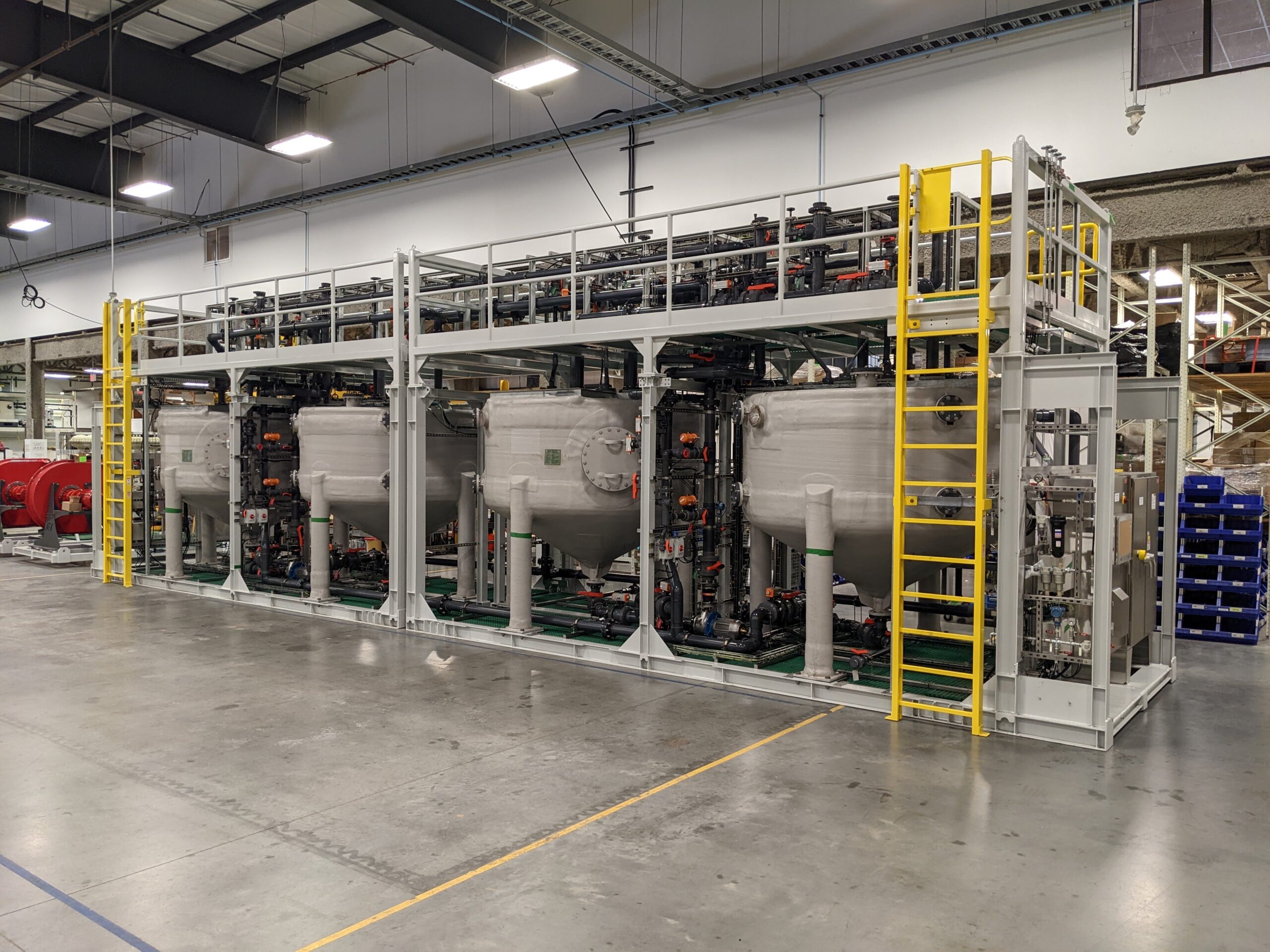
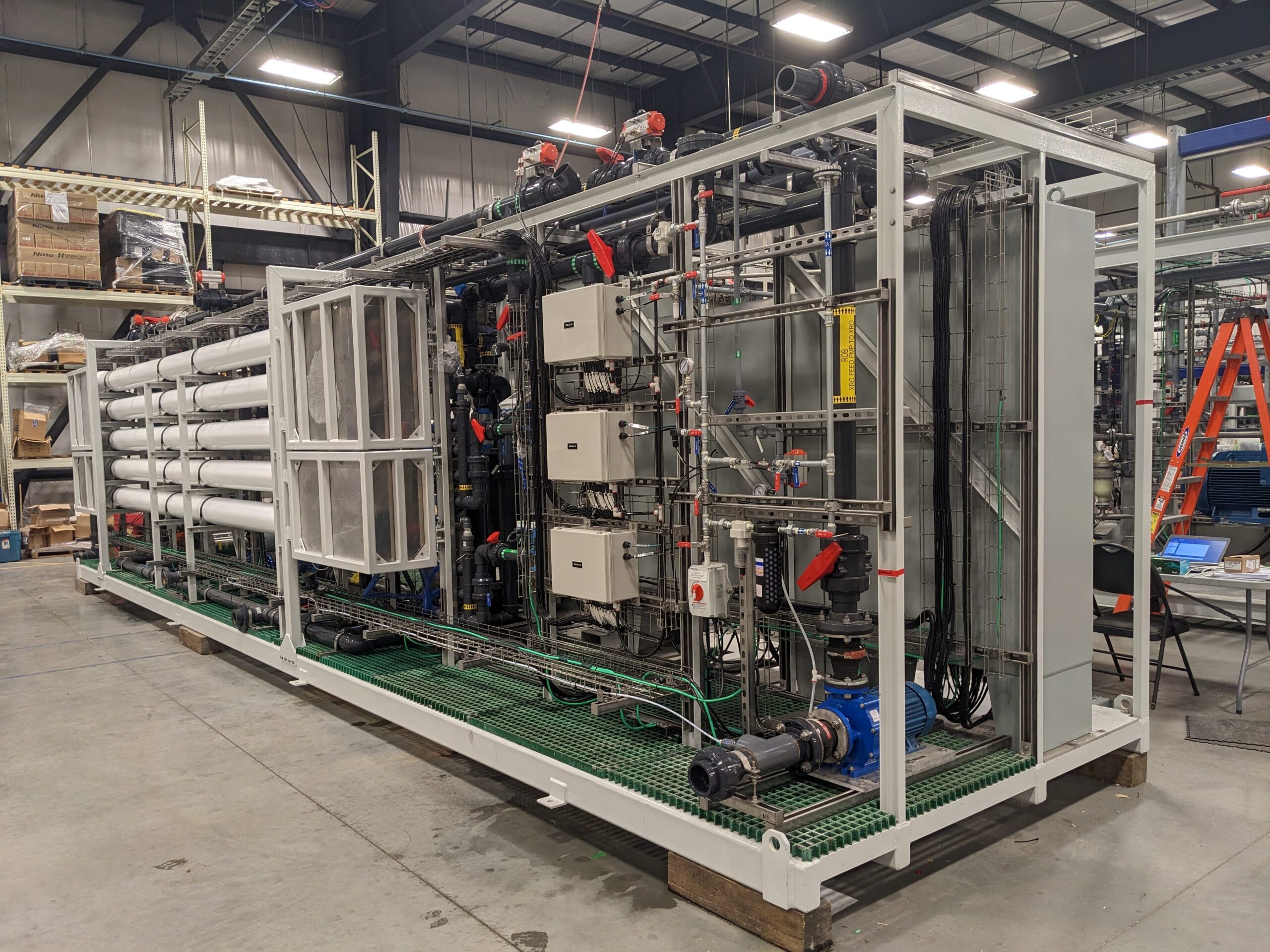
Saltworks’ BrineRefine and XtremeRO Units at Saltworks’ HQ
To conclude, osmotically assisted RO is not the “new kid on the block” but it does stand as a turning point for concentrating and refining technology. OARO is a novel arrangement of components already widely available in the industrial supply chain, implying a short road to full commercialization at cost competitiveness.
And, while fouling and membrane health still limit the tech’s ability to deal with harsher feedwater, innovation across the sector should result in more resilient systems in the near future. But for now, careful consideration of feedwater chemistry is key to an energy-and-cost-efficient OARO system.
Considering OARO?
The Saltworks team is pleased to offer our OARO system, pilots, and analysis to qualified customers. Reach out to speak with our experts and begin to optimize your brine concentration system today.
About Saltworks
Saltworks Technologies is a leader in the development and delivery of solutions for industrial wastewater treatment and lithium refining. By working with customers to understand their unique challenges and focusing on continuous innovation, Saltworks’ solutions provide best-in-class performance and reliability. From its headquarters in Richmond, BC, Canada, Saltworks’ team designs, builds, and operates full-scale plants, and offers comprehensive onsite and offsite testing services with its fleet of mobile pilots.
